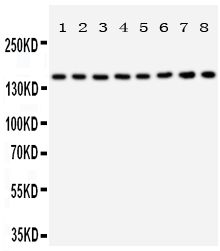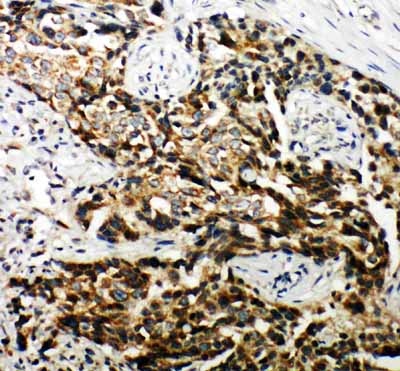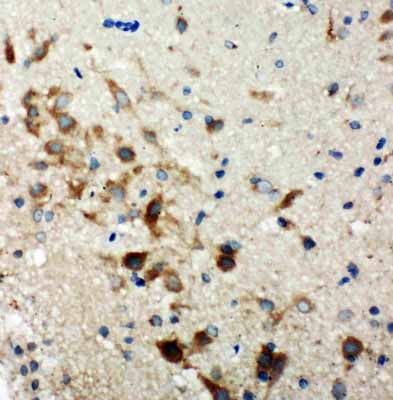Anti-Hamartin Antibody
- SPECIFICATION
- CITATIONS
- PROTOCOLS
- BACKGROUND

Application
| WB, IHC-P |
|---|---|
| Primary Accession | Q92574 |
| Host | Rabbit |
| Reactivity | Human, Mouse, Rat |
| Clonality | Polyclonal |
| Format | Lyophilized |
| Description | Rabbit IgG polyclonal antibody for Hamartin(TSC1) detection. Tested with WB, IHC-P in Human;Mouse;Rat. |
| Reconstitution | Add 0.2ml of distilled water will yield a concentration of 500ug/ml. |
| Gene ID | 7248 |
|---|---|
| Other Names | Hamartin, Tuberous sclerosis 1 protein, TSC1, KIAA0243, TSC |
| Calculated MW | 129767 MW KDa |
| Application Details | Immunohistochemistry(Paraffin-embedded Section), 0.5-1 µg/ml, Human, Mouse, Rat, By Heat Western blot, 0.1-0.5 µg/ml, Human, Rat, Mouse |
| Subcellular Localization | Cytoplasm . Membrane ; Peripheral membrane protein . At steady state found in association with membranes. |
| Tissue Specificity | Highly expressed in skeletal muscle, followed by heart, brain, placenta, pancreas, lung, liver and kidney. Also expressed in embryonic kidney cells. |
| Protein Name | Hamartin |
| Contents | Each vial contains 5mg BSA, 0.9mg NaCl, 0.2mg Na2HPO4, 0.05mg Thimerosal, 0.05mg NaN3. |
| Immunogen | A synthetic peptide corresponding to a sequence at the C-terminus of human Hamartin(1150-1164aa QLHIMDYNETHHEHS), identical to the related rat sequence, and different from the related mouse sequence by one amino acid. |
| Purification | Immunogen affinity purified. |
| Cross Reactivity | No cross reactivity with other proteins |
| Storage | At -20˚C for one year. After r˚Constitution, at 4˚C for one month. It˚Can also be aliquotted and stored frozen at -20˚C for a longer time.Avoid repeated freezing and thawing. |
| Name | TSC1 {ECO:0000303|PubMed:9242607, ECO:0000312|HGNC:HGNC:12362} |
|---|---|
| Function | Non-catalytic component of the TSC-TBC complex, a multiprotein complex that acts as a negative regulator of the canonical mTORC1 complex, an evolutionarily conserved central nutrient sensor that stimulates anabolic reactions and macromolecule biosynthesis to promote cellular biomass generation and growth (PubMed:12172553, PubMed:12906785, PubMed:12271141, PubMed:28215400, PubMed:15340059, PubMed:24529379). The TSC-TBC complex acts as a GTPase-activating protein (GAP) for the small GTPase RHEB, a direct activator of the protein kinase activity of mTORC1 (PubMed:12906785, PubMed:15340059, PubMed:24529379). In absence of nutrients, the TSC-TBC complex inhibits mTORC1, thereby preventing phosphorylation of ribosomal protein S6 kinase (RPS6KB1 and RPS6KB2) and EIF4EBP1 (4E-BP1) by the mTORC1 signaling (PubMed:12271141, PubMed:24529379, PubMed:28215400). The TSC- TBC complex is inactivated in response to nutrients, relieving inhibition of mTORC1 (PubMed:12172553, PubMed:24529379). Within the TSC-TBC complex, TSC1 stabilizes TSC2 and prevents TSC2 self- aggregation (PubMed:10585443, PubMed:28215400). Acts as a tumor suppressor (PubMed:9242607). Involved in microtubule-mediated protein transport via its ability to regulate mTORC1 signaling (By similarity). Also acts as a co-chaperone for HSP90AA1 facilitating HSP90AA1 chaperoning of protein clients such as kinases, TSC2 and glucocorticoid receptor NR3C1 (PubMed:29127155). Increases ATP binding to HSP90AA1 and inhibits HSP90AA1 ATPase activity (PubMed:29127155). Competes with the activating co-chaperone AHSA1 for binding to HSP90AA1, thereby providing a reciprocal regulatory mechanism for chaperoning of client proteins (PubMed:29127155). Recruits TSC2 to HSP90AA1 and stabilizes TSC2 by preventing the interaction between TSC2 and ubiquitin ligase HERC1 (PubMed:16464865, PubMed:29127155). |
| Cellular Location | Lysosome membrane; Peripheral membrane protein. Cytoplasm, cytosol Note=Recruited to lysosomal membranes in a RHEB-dependent process in absence of nutrients (PubMed:24529379). In response to nutrients, the complex dissociates from lysosomal membranes and relocalizes to the cytosol (PubMed:24529379). |
| Tissue Location | Highly expressed in skeletal muscle, followed by heart, brain, placenta, pancreas, lung, liver and kidney (PubMed:9242607). Also expressed in embryonic kidney cells (PubMed:9242607). |

Thousands of laboratories across the world have published research that depended on the performance of antibodies from Abcepta to advance their research. Check out links to articles that cite our products in major peer-reviewed journals, organized by research category.
info@abcepta.com, and receive a free "I Love Antibodies" mug.
Provided below are standard protocols that you may find useful for product applications.
Background
TSC1(Tuberous Sclerosis 1), also called HAMARTIN or TSC, is a human protein and gene. As part of a comprehensive strategy to identify the gene mutant in tuberous sclerosis-1, van Slegtenhorst et al.(1997) developed an overlapping contig of clones from the 1.4-Mb TSC1 region on chromosome 9. Benvenuto et al.(2000) showed that overexpression of the TSC1 gene in rat fibroblasts inhibits growth and causes changes in cell morphology. Van Slegtenhorst et al.(1998) showed that hamartin and tuberin associate physically in vivo, however, and that the interaction is mediated by predicted coiled-coil domains.
If you have used an Abcepta product and would like to share how it has performed, please click on the "Submit Review" button and provide the requested information. Our staff will examine and post your review and contact you if needed.
If you have any additional inquiries please email technical services at tech@abcepta.com.













 Foundational characteristics of cancer include proliferation, angiogenesis, migration, evasion of apoptosis, and cellular immortality. Find key markers for these cellular processes and antibodies to detect them.
Foundational characteristics of cancer include proliferation, angiogenesis, migration, evasion of apoptosis, and cellular immortality. Find key markers for these cellular processes and antibodies to detect them. The SUMOplot™ Analysis Program predicts and scores sumoylation sites in your protein. SUMOylation is a post-translational modification involved in various cellular processes, such as nuclear-cytosolic transport, transcriptional regulation, apoptosis, protein stability, response to stress, and progression through the cell cycle.
The SUMOplot™ Analysis Program predicts and scores sumoylation sites in your protein. SUMOylation is a post-translational modification involved in various cellular processes, such as nuclear-cytosolic transport, transcriptional regulation, apoptosis, protein stability, response to stress, and progression through the cell cycle. The Autophagy Receptor Motif Plotter predicts and scores autophagy receptor binding sites in your protein. Identifying proteins connected to this pathway is critical to understanding the role of autophagy in physiological as well as pathological processes such as development, differentiation, neurodegenerative diseases, stress, infection, and cancer.
The Autophagy Receptor Motif Plotter predicts and scores autophagy receptor binding sites in your protein. Identifying proteins connected to this pathway is critical to understanding the role of autophagy in physiological as well as pathological processes such as development, differentiation, neurodegenerative diseases, stress, infection, and cancer.




